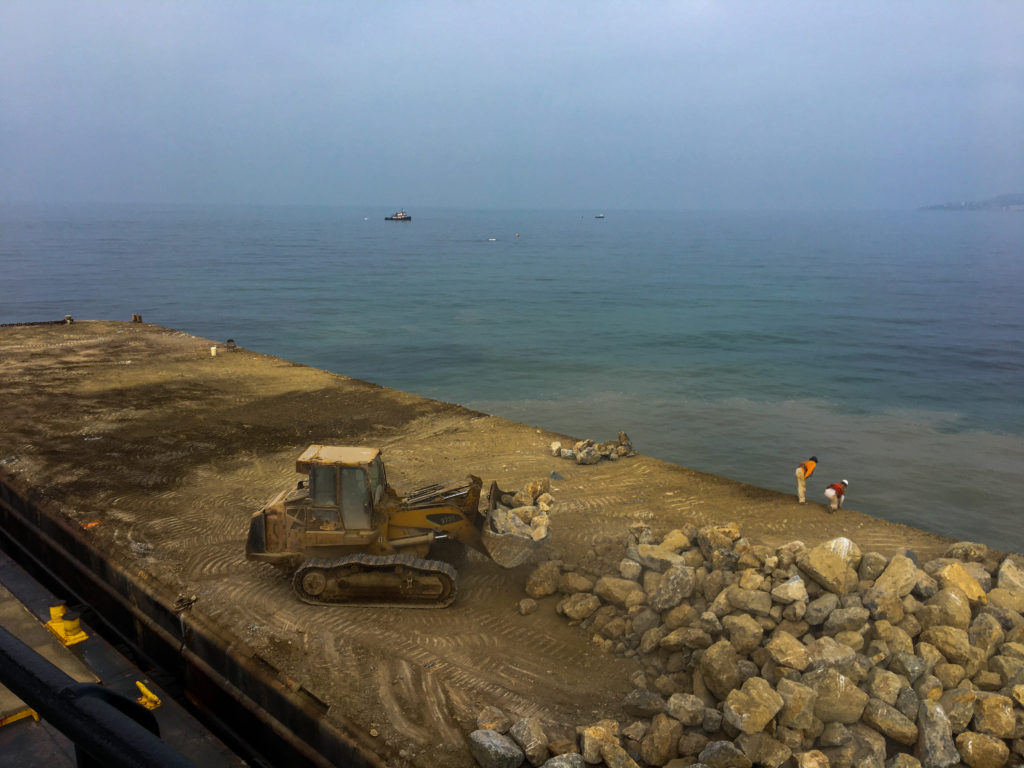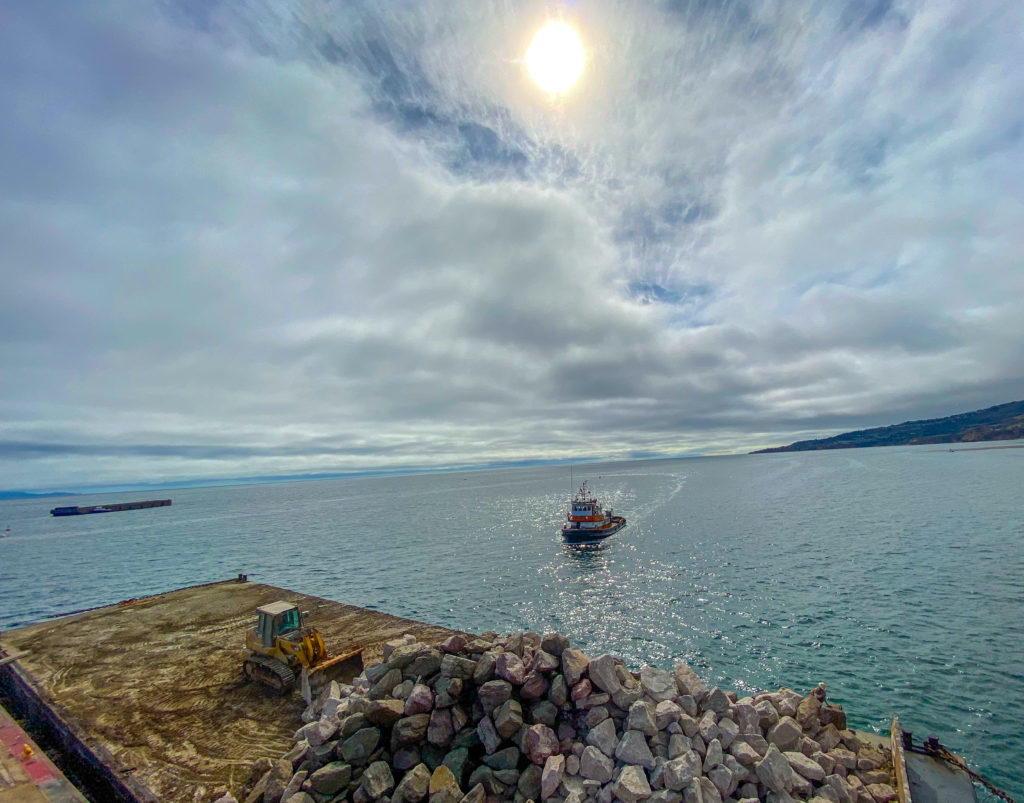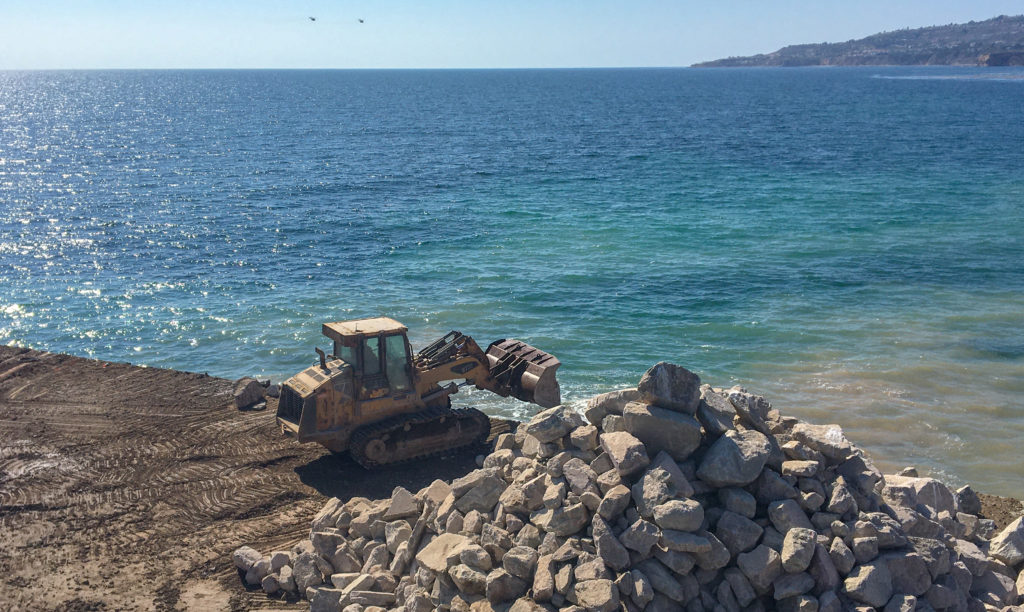SCMI working with the Vantuna Research Group at Occidental College has permitted and is the lease holder for the construction of the first offshore restoration rocky reef in California’s history (Figure 1). The project was constructed spring and summer of 2020 on the Palos Verdes Peninsula. The peninsula has suffered from historic anthropogenic stressors that have resulted in significant and well documented losses and of rocky-reef and kelp bed habitat. This loss of habitat and associated ecosystem services has reduced socioeconomic benefits to the region. This project has restored critical habitat for important fish and invertebrate fishery species that have been impacted from historical watershed mismanagement. Stretches of the rocky reefs and kelp forests that surround the Palos Verdes Peninsula in Los Angeles County have been impacted from chronic sedimentation that are at least partially the result of human caused landslides and urban runoff over the past 70 years. While many of the sources of the sedimentation have been ameliorated, over 200 acres of reef habitat have been lost to sedimentation, continued reef scour and burial. However, some smaller areas of reef along this coastline that are naturally high relief (extend vertically up from the seafloor) remain some of the most productive in southern California for commercially and recreationally important fish and invertebrates. This restoration project will use a peer reviewed published design based on the best available science that mimics the productive characteristics of these existing natural reefs to restore the productivity of these sediment impacted areas by creating high relief quarry rock reef modules that will extend up from the seafloor above the moving sediment.

Reef Design
The restoration reef is designed as set of eight “blocks”. Each block contains three modules (A, B, C). Each module consists of a 3 x 2 set of six “piles”. The three piles on each side of the module are offset by 1/2 of the pile width (8 m). Each pile is a 16 m x 16 m square pyramid of quarry rock with an overall height of 1 m, 2 m, 3 m, or 4 m. The blocks will be in two designs, either with a 3 m overall pile height or a 4 m overall pile height. There is a 10 to 20 m wide sand channel between modules and at least 50 m of space between blocks. These distances were chosen due to the previously described ‘halo’ effect around reef of ~30 m. Reef modules that are separated by < 30 m are more likely to operate as a single reef for many species, while blocks separated by > 30 m operate more independently. In our design criteria reef blocks are spaced at least 50 m apart. By separating the blocks and modules by the appropriate distances we can restore a greater amount of reef perimeter sand-rock ecotone habitat and we can increase the independence of replicate reef blocks. The overall approach is to try to balance scientific study design considerations with maximizing the potential for an effective restoration effort across the range of important species, and kelp forest biodiversity. Major motivations included incorporating heterogeneity throughout the restoration reef design both within (e.g., varying pile heights within blocks) and amongst (e.g., varying block orientation across blocks) the reef blocks. Not only will this project restore an enormous amount of lost reef habitat, but we have also embedded into it a repeated statistical design that will allow a variety of research project to be conducted in a replicated manner. As you can imagine, this unique opportunity has sparked a lot of interest. Please contact Dr. Pondella if you have any questions.

Monitoring
Construction on the Palos Verdes restoration reef began on May 7, 2020 and competed on September 22, 2020. During construction SCMI staff sampled surface water to assess changes in water quality parameters (Table 1) at three sites surrounding the Derrick Barge Long Beach and served as Protected Species Observers/Marine Mammal Observers aboard the barge. Baseline surface water was sampled prior to each phase of construction. As Protected Species Observers/Marine Mammal Observers SCMI staff monitored and recorded; changes in vessel activity/position, and environmental variables; sightings of marine mammals and changes in behavior due to construction; administer operation shutdowns when mammals entered the safety zone; a 152-meter (about half the height of the Empire State Building) radius around the construction zone.

Table 1: Water quality parameters taken, frequency, and limitations. (Vantuna Research Group. (2020). Post-Construction Report for Palos Verdes Reef Restoration Project 3(1), 10.)
During the reef construction, we observed approximately 826 marine mammals, across 94 sightings, with 42 entries into the safety zone. Of these 826 observations; 431 were unidentified species in the Delphindae family, 22 were common dolphins (Delphinus delphus), and 345 were bottlenose dolphins (Tursiops truncatus); 46 were California Sea Lions (Zalophus californianus) (Table 2). A total of 223 minutes (about 3 and a half hours) of shutdowns were administered to maintain mammal safety. Although, most behavior changes recorded were diving below the barge or a change in direction of travel, there were a few occurrences when mammals interacted with construction equipment and/or vessels. One interesting interaction, resulting in a 43-minute shutdown, was then a California Sea Lion with a fresh shark bite repeatedly attempted to board the barge.

Table 2: Marine wildlife observations, observation events, safety zone entries, required construction shutdowns, and length of required construction shutdowns. (Vantuna Research Group. (2020). Post-Construction Report for Palos Verdes Reef Restoration Project 3(2), 12.)
We are so proud to have been able to be a part of this project and are excited to oversee all the future research and restoration that will pertain to these reefs. It was quite a sight to see the large 250-foot work barge with a crew of 12 operating anchor cables, bulldozers, cranes, and tugboats to construct the 24 modules of the reef. We would like to thank all the parties that put in time and effort to make this wonderful project come to life. More information about the project can be found on the Vantuna Research Group website: https://www.oxy.edu/academics/vantuna-research-group/palos-verdes-reef.
Check out buoy data above the reef here: https://aqualink.org/reefs/3184




Press
Check out these features:
Palos Verdes Reef Restoration Project A Success: Report, Patch.com August 11, 2022
Palos Verdes Peninsula reef restoration project shows fast success, Daily Breeze August 10, 2022
The Palos Verdes Reef Restoration Project: Turning Back the Hands of Time By Steve Tabor, Palos Verdes Pulse
58,000 tons of rock will create a new artificial reef off Palos Verdes Peninsula, Daily Breeze
Palos Verdes Reef Restoration Project begins again this week, Palos Verdes Peninsula News
Toilets, Streetcars, and Light Poles—A Brief History of Artificial Reefs in Southern California, H2O Radio
